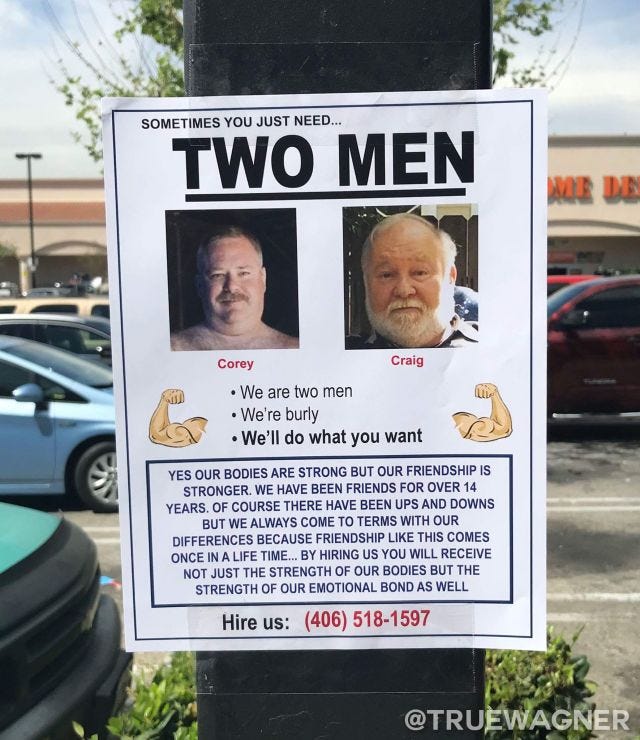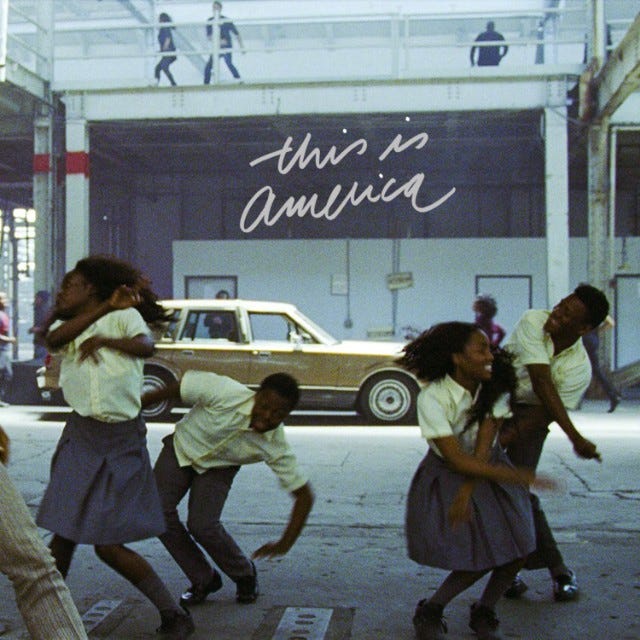EPISODE 315: PLEASE CHANGE YOUR RULE

POP CULTURE SPIRIT WOW
The main problem with simulating your own physical discorporation in a weekly newsletter is that it’s a pretty tiny corner you’ve painted yourself into. The sequel to Infinity War doesn’t come out for another year, and the resolution of its cliffhanger is unknown. Where’s the out?
That was always Breaking Bad’s great strength – they were fearless about putting their (anti-)heroes in impossible situations. And not only that, but demanding that their solutions make sense. No Deus, all machina.
In my case, there’s also the fear that some (many) (most) read last week have not seen Infinity War and therefore took last week as some sort of glitch, or worse, newsletter sloppiness – an interpretation I did nothing to dispel by sending the #!%! thing out before I’d added the Star Wars images that are obliquely referenced. (They're coming soon...but not today...)
‘Don’t worry, your mistake adds to the overall vibe you were going for,’ I told myself.
(Yeah. Okay. Sure, kid.)
Having said all that, here’s the thing: At the end of Infinity War, what did we see, precisely? It clearly looks like one thing happened, a really bad thing, something you might have seen on HBO but worse.
(Trying not to totally spoil that thing. But it has been two weeks...
It’s a good movie, really good. The movie Captain America: Civil War wanted to be. The movie Marvel had been dreaming of and promising from the very beginning. I’d even say Thanos is the best comic book movie villain, period. Even better than Black Panther’s Killmonger.)
Anyway, yes, we seemed to see one thing at the end of Infinity War.
But it turns out, the situation is different than we thought. I don’t want to give away too much, because it will ruin the next movie, but let me say this much: think about the scene where Drax and Mantis faced Thanos. Something happened to them—something you would not think would be a good thing to have happen, a fun life experience, unless you are were a giant human child looking for toys to play with -- and yet they were still also themselves. Conscious and all.
It’s pretty much the same with me right now. I’m still getting used to how to type like this, and if another person rolls a Roomba at me I am going to LOSE IT. But for now, we’re all good.
If the CW ever makes a comic book scifi nerd squad version of Breaking Bad, I am such a lock.
++
Vaguely related: Two of the biggest shows of the last ten years were about a man who became a monster for reasons he insisted had to do with the well-being of his family, but actually were largely due to his own feelings of impotence; and about a woman who fights for a life of her own after her husband pretty much destroys their lives with his dishonesty and repeated infidelities (The Good Wife).
I don’t want to put Western society on the couch, but it doesn’t seem like a reach to say our TV choices were trying to tell us something...
(Also: Nielsen Ratings as Collective Unconsciousness which eventually takes on a massive physical form is a Lovecraft story I would definitely watch.)
++

Rihanna at NYC's Met Gala This Week.
Some Catholics went insane over pop stars wearing religious garb.
(The theme was Fashion and the Catholic Church.)
Not so much New York City Cardinal Dolan.
He lent Rihanna his mitre.
(True story.)
++
A busy week. Lots of writing-huzzah! Also a trip between San Francisco and Los Angeles that involved a 4am car ride, a train, two BARTs, an AirTram, a flight, two buses and about eight hours of my life. Travel=Funtime.
Really the biggest thing this week, though, has been Childish Gambino’s video “This is America”, which is sort of like what if instead of using a bedazzled glove Thanos did what he did by releasing a music video.

If you haven’t seen it, it’s a bit hard to explain. Here’s the link. Let me warn you, there are a few moments of brutal violence in it. In fact it’s not the sort of thing I would normally post here, except that it is such a provocative and challenging piece of work.
Depending on who you ask, the video is about gun violence, the racism of media representations of black people (and/or their participation in those tropes), or our very act of consumption, how much we sometimes allow our desire to be entertained to overwhelm any sense of empathy or justice.
I suspect that many watching the video will just find it offensive and leave it at that. And a further hunch is that that will especially include religious-minded people.
And to my mind that’s unfortunate. Because on a whole other level “This is America” is about the most difficult aspect to achieve in a life of faith, namely real conversion.
++
If you were going to take a poll of the greatest American Catholic writers, Flannery O’Connor would win that poll by a huge margin. (Sorry Walker Percy. You my boy, but Flannery tho.)
She wrote barely anything – a bunch of short stories and two novellas – and died before she was 40.
But her stories had a way of staying with you, in large part because they were often shocking and violent. Families get murdered. People are publicly humiliated for their complacency or prejudice. Children drown.
And as strange as it may sound, for O’Connor that element of violence was essential. A life guided by faith, O’Connor believed, is not only difficult, but nearly impossible, because none of us actually want the sacrifices that it involves. Everyone’s happy about going to Heaven and being loved for who they are, but tell me I have to forgive people and you can forget about it.
In fact, O’Connor argues, we do one better than that – we do our very best to forget those demands ourselves, whether by conscious act or by the society we’ve built up around us, a sort of NIMBY super-shield that can keep us isolated from those to whom we might have an obligation.
In that kind of context, the only thing that might possibly break through, says O’Connor, the only thing that can lead most of us to a real opening of our hearts, is some kind of experience of violence – something so dramatically jarring or shattering that our complacency-coping mechanisms temporarily fail.
It’s akin to when tragedy occurs unexpectedly; suddenly you realize the rules of the game you’ve been playing are not in fact the rules and also that this is a different game. It’s an awful, floor-dropping-out sensation, and our instinct is to run from it back to security and stability as quickly as we can.
Except now we know that’s all just comfy fiction, the summer novel or tent pole movie version of reality. And so running away doesn’t really work either. We’re stuck having to face the scary truth of it all.
“This is America” is a similarly O’Connoresque response, but to a different object of faith. Donald Glover (aka Childish Gambino) lures in with a warm, richly textured opening melody that something poppy and inconsequential, Song of the Summer 2018 Baby!, then turns the tables in sudden and explosive fashion and leaves us reeling.
We talk about America as this grand experiment in democracy, a place of life, liberty and the pursuit of happiness, a beloved community in which everyone has a place at the table. But that’s just not the reality, not at all. And Gambino refuses to let us look away.
++
Writer Gets His Envy On, Part I: As tough as it is to watch at all, it’s really hard to watch “This is America” just once. Something about it just keeps pulling you back.
Certainly the storyline, performance and cinematography are part of that. But I think the real hook is the story’s relative inaccessibility. What did I just watch? I wondered after the first viewing. I don’t know. I think I need to watch it again.
A combination of coherence and ambiguity, the catnip of good storytelling.
++
Writer Gets His Envy On, Part II: Christianity is built around difficult/problematic ideas of redemptive violence. Just like the Passover Lamb, we’re told, Jesus died to save us.
And if you’re wondering about the divine physics of how that works, or why the Big G would need someone/Himself to be murdered in order for us to be forgiven, yeah, me, too. These are ideas from the ancient world that ill-befit Jesus, but even two thousand years we’re still coming to grips with that. But your mileage may vary.
No matter, though, consider the genius of O’Connor: she keeps the idea of the redemptive act of violence, but instead of applying it to some external savior she turns it on us. We are the lambs led to the slaughter, and that violence redeems us insofar as it liberates us from the comfy fictions in which we try to slumber.
Flannery O’Connor, The Complete Stories.
++

-- Your friend, Rihanna
++ LINKS ++
I can't tell if this is a game about selling paperclips or a nightmare about a screen I can't understand but won't look away from. But it is about paperclips, so...
John Mulaney gives a take on the world today that manages to turn crazy into joy.
Tiffany Haddish offers a blessing on her audience that is too foul-mouthed for Sunday Mass and yet I would pay to hear a priest say it there.
And then there's this, from Grey's Anatomy last night:
In Japan when a piece of pottery breaks, some potters fill the cracks with gold. The potters, they see the repairs as something beautiful. They know that the unexpected happens. Change happens. They know that nobody gets through this world in one piece. That doesn’t have to diminish us. The cracks are part of our history. They will always be with us. They made us better. They made us stronger. They made us something new.
I like that. We're not going to get through this world in one piece. We get to be something new.
Here we go.

